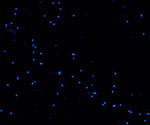Volume 27, Number 6—June 2021
Etymologia
Etymologia: Enterocytozoon bieneusi
Enterocytozoon bieneusi [′entərəˌsaitə′ӡu:ən bıə′nəʊsı]
From the Greek énteron (intestine), kútos (vessel, cell), and zỗion (animal), and the surname Bieneus, in memory of the first infected patient whose case was reported in Haiti during 1985. Enterocytozoon bieneusi, a member of the wide-ranging phylum Microsporidia, is the only species of this genus known to infect humans. Microsporidia are unicellular intracellular parasites closely related to fungi, although the nature of the relationship is not clear (Figure).
E. bieneusi, a spore-forming, obligate intracellular eukaryote, was discovered during the HIV/AIDS pandemic and is the main species responsible for intestinal microsporidiosis, a lethal disease before widespread use of antiretroviral therapies. More than 500 genotypes are described, which are divided into different host-specific or zoonotic groups. This pathogen is an emerging issue in solid organ transplantation, especially in renal transplant recipients.
References
- Desportes I, Le Charpentier Y, Galian A, Bernard F, Cochand-Priollet B, Lavergne A, et al. Occurrence of a new microsporidan: Enterocytozoon bieneusi n.g., n. sp., in the enterocytes of a human patient with AIDS. J Protozool. 1985;32:250–4. DOIPubMedGoogle Scholar
- Didier ES, Weiss LM. Microsporidiosis: not just in AIDS patients. Curr Opin Infect Dis. 2011;24:490–5. DOIPubMedGoogle Scholar
- Han B, Weiss LM. Microsporidia: obligate intracellular pathogens within the fungal kingdom. Microbiol Spectr. 2017;5:97–113.PubMedGoogle Scholar
- Moniot M, Nourrisson C, Faure C, Delbac F, Favennec L, Dalle F, et al. Assessment of a multiplex PCR for the simultaneous diagnosis of intestinal cryptosporidiosis and microsporidiosis: epidemiologic report from a French prospective study. J Mol Diagn. 2021;23:417–23. DOIPubMedGoogle Scholar
Figure
Cite This ArticleOriginal Publication Date: April 29, 2021
Related Links
Table of Contents – Volume 27, Number 6—June 2021
| EID Search Options |
|---|
|
|
|
|
|
|

Please use the form below to submit correspondence to the authors or contact them at the following address:
Maxime Moniot, Laboratoire de Parasitologie Mycologie, Centre Hospitalier Universitaire, 58 Rue Montalembert, Gabriel Montpied 63003, Clermont-Ferrand CEDEX 1, France
Top